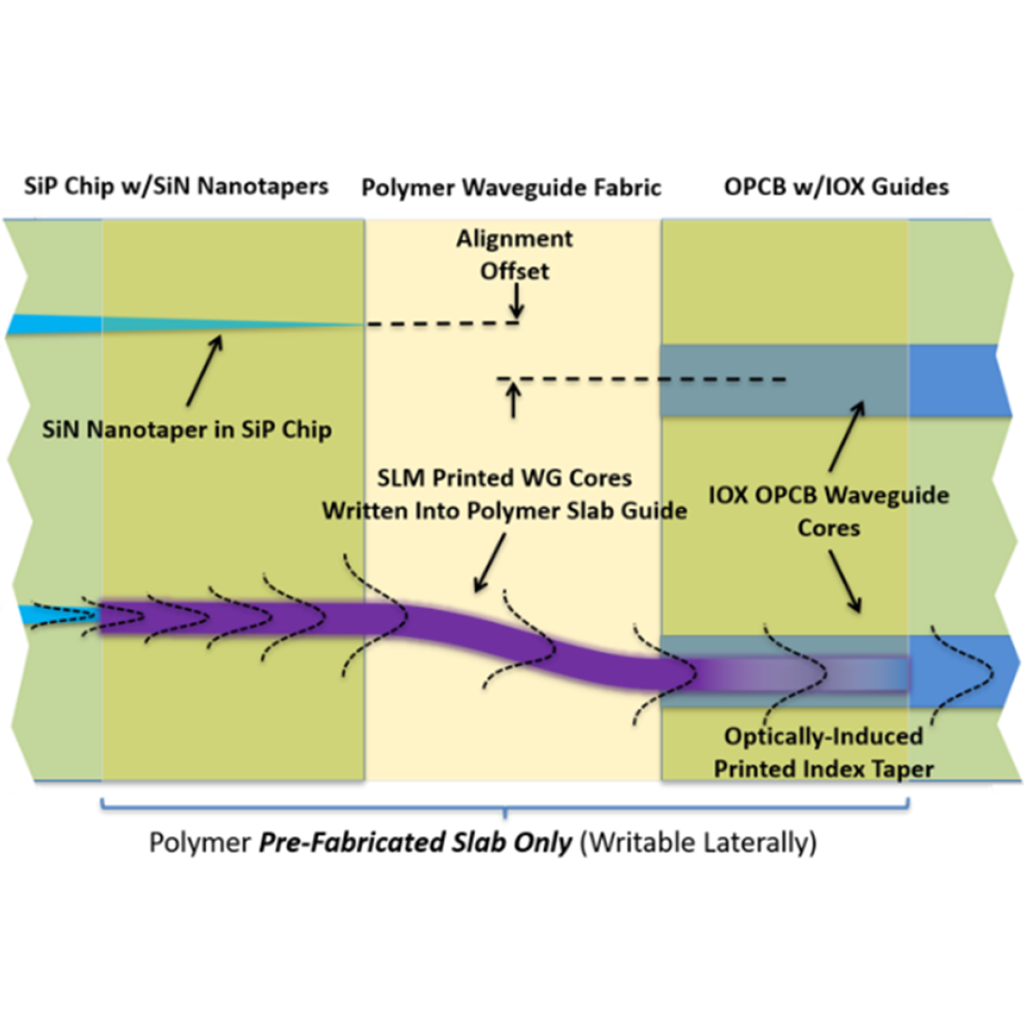New polymer materials make fabricating optical interconnects easier
About Optica
13 April 2022
New polymer materials make fabricating optical interconnects easier
New technology poised to make silicon photonics more practical, which could boost efficiency of Internet data centers
WASHINGTON — Researchers have developed new polymer materials that are ideal for making the optical links necessary to connect chip-based photonic components with board-level circuits or optical fibers. The polymers can be used to easily create interconnects between photonic chips and optical printed circuit boards, the light-based equivalent of electronic printed circuit boards.
“These new materials and the processes they enable could lead to powerful new photonic modules based on silicon photonics,” said research team leader Robert Norwood from the University of Arizona. “They could also be useful for optical sensing or making holographic displays for augmented and virtual reality applications.

Caption: Researchers use what they call a SmartPrint process to develop new polymer materials
Image Credit: Robert Norwood, University of Arizona
Silicon photonics technology allows light-based components to be integrated onto a tiny chip. Although many of the basic building blocks of silicon photonic devices have been demonstrated, better methods are needed to fabricate the optical connections that link these components together to make more complex systems.
.jpg?t=637854414163561113) In the journal Optical Materials Express, the researchers report new polymer materials that feature a refractive index that can be adjusted with ultraviolet (UV) light and low optical losses. These materials allow a single-mode optical interconnect to be printed directly into a dry film material using a low cost, high throughput lithography system that is compatible with the CMOS manufacturing techniques used to make chip-based photonic components.
In the journal Optical Materials Express, the researchers report new polymer materials that feature a refractive index that can be adjusted with ultraviolet (UV) light and low optical losses. These materials allow a single-mode optical interconnect to be printed directly into a dry film material using a low cost, high throughput lithography system that is compatible with the CMOS manufacturing techniques used to make chip-based photonic components.
“This technology makes it more practical to fabricate optical interconnects, which can be used to make the Internet — especially the data centers that make it run — more efficient,” said Norwood. “Compared to their electronic counterparts, optical interconnects can increase data throughput while also generating less heat. This reduces power consumption and cooling requirements.”
Replacing wires with light
The research expands on a vinylthiophenol polymer material system known as S-BOC that the investigators developed previously. This material has a refractive index that can be modified using UV illumination. In the new work, the researchers partially fluorinated S-BOC to improve its light efficiency. The new material system, called FS-BOC, exhibits lower optical propagation losses than many other optical interconnect materials.
“With this material we can use a process that we call SmartPrint to directly write optical interconnections between different optical printed circuit board elements, such as ion-exchange (IOX) glass waveguides provided by our collaborator Lars Brusberg from Corning Incorporated,” said Norwood.
To perform the SmartPrint process, a FS-BOC film is applied directly to a photonic component. No mechanical alignment is needed because the optical interconnect is made using a maskless lithography system that calculates where the interconnect is required by looking at the components and then writing the optical interconnect into the polymer using photoexposure. No additional processing is necessary other than briefly heating the polymer film to 90 °C. Because the fabrication approach is maskless, writing patterns can be changed without making a new photomask.
Creating a connection
To demonstrate the new materials, the researchers deposited them directly onto ion-exchange glass waveguide arrays, which are commonly used for integrated photonic devices. They then printed the coupling features needed to allow light to travel out of one IOX waveguide, propagate into the newly fabricated polymer interconnect, and then enter a second IOX waveguide adjacent to the initial IOX waveguide.
According to the researchers, the polymer optical interconnects worked well and showed low propagation and coupling losses, which means very little light was lost as it traveled within the interconnect or between it and the other components.
The researchers are now working to improve the material’s refractive index contrast and performance at high temperatures. “A higher refractive index contrast would make the material more tolerant to manufacturing variations while high temperature performance is likely needed for the interconnect to withstand solder reflow processes, which take place above 200 °C,” said Norwood.
Paper: J. I Frish, T. S. Kleine, R. Himelhuber, S. Showghi, A. Nishant, K.-J. Kim, L. Jiang, L. Brusberg, S. Pau, T. L. Koch, J. Pyun, R. A. Norwood, “Rapid Photolithographic Fabrication of High Density Optical Interconnects using Refractive Index Contrast Polymers,” Opt. Mater. Express Vol. 12, Issue 5, pp. 1932-1944 (2022)
https://doi.org/10.1364/OME.454195
About Optica Publishing Group
Optica Publishing Group is a division of the society, Optica, Advancing Optics and Photonics Worldwide. It publishes the largest collection of peer-reviewed and most-cited content in optics and photonics, including 18 prestigious journals, the society’s flagship member magazine, and papers and videos from more than 835 conferences. With over 400,000 journal articles, conference papers and videos to search, discover and access, our publications portfolio represents the full range of research in the field from around the globe.
About Optical Materials Express
Optical Materials Express is an open-access journal focusing on the synthesis, processing and characterization of materials for applications in optics and photonics. It is published by Optica Publishing Group and emphasizes advances in novel optical materials, their properties, modeling, synthesis and fabrication techniques; how such materials contribute to novel optical behavior; and how they enable new or improved optical devices. The Editor-in-Chief is Andrea Alù from City University of New York, USA. For more information, visit Optical Materials Express.
Media Contact
